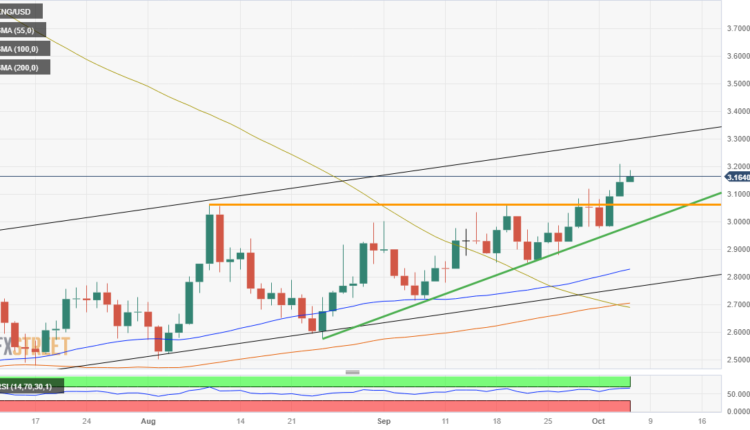Natural Gas jumps higher as weather models show substantial drop in temperatures ahead
- Natural Gas price soars near $3.20.
- The US Dollar eases after soft figures for both ISM Services PMI and ADP Employment Change.
- US Natural Gas prices could head higher on the possibility of a cold front coming in sooner than expected.
Natural Gas prices are soaring despite the lackluster demand from Europe where gas storages are filled to the brim. Traders rather appear to be focusing on the potential cold front that should kick in later this week. It looks like the current grace period for European gas consumption will not be that long and that by the end of this month households will jack up their thermostats.
The US Dollar (USD) is clueless for direction this Thursday with several asset classes trying to claw back against the ferocious Greenback. After parts of the equity, commodity and bond markets all reached yearly lows over the past week, it does not come as a surprise that all these elements are up this Thursday. The ADP and Institute of Supply Management (ISM) numbers from Wednesday took a fair bit of wind out of the sales of the US Dollar Index.
Natural Gas is trading at $3.18 per MMBtu at the time of writing.
Natural Gas news and market movers
- European storage sites are reporting another hike in reserves to 96.33%.
- Fuel shipments from Norway, the top gas supplier for the EU, are recovering and are set to hit the highest level since August once the last gas fields are fully back online.
- The most recent weather models show a substantial drop in temperatures by mid-October in Europe, which means that the current higher-than-normal temperatures aren’t expected to last long.
- Meanwhile in Australia, Chevron has reneged on the commitment it gave to the Fair Work Commission and could dent the current agreement in place in order to dissolve the strikes in Wheatstone and Gorgon LNG facilities. Union workers are set to reconvene on Thursday to discuss a possible restart of strikes.
- Turkey’s Energy Minister Alparslan Bayraktar says he will travel to Israel in November to meet his counterpart and energy companies operating in the gas industry. Turkey wants to develop a framework with Israel when it comes to energy. Turkey would buy natural gas from Israel for domestic use and would also send a fraction to the European market.
- In all these headlines, one would almost forget that near 14:30 GMT the weekly Energy Information Administration (EIA) Natural Gas Storage Change for the last week of September is due. Expectations are for another build from 90 to 92 Billion cubic feet.
Natural Gas Technical Analysis: flirt with $3.20
Natural Gas is soaring higher this week, with traders ignoring the higher temperatures in Europe and rather focusing on the cold front coming in. Traders are presuming that the EU will want to keep its gas reserves filled to the brim, and will buy at any time. With this prepositioning, a quick squeeze higher in the coming weeks could materialise.
The pivotal level near $3.07 has been broken again to the upside. This level needs to hold now as a new floor, squeezing prices higher. With respect of the ascending trend channel, the upside looks limited toward $3.30 to test the upper barrier.
On the downside, the newly formed floor at $3.07 should act as support together with the psychological $3 big figure. In case demand abates further, or more supply out of Norway comes back online, expect to see an initial drop back to the green ascending trendline near $2.95. Should that give way, $2.80 is an area with two moving averages (the 55-day and the 100-day) and the lower barrier of the trend channel that could encourage bulls to catch any falling price action.
-638320939616951616.png)
XNG/USD (Daily Chart)
Natural Gas FAQs
Supply and demand dynamics are a key factor influencing Natural Gas prices, and are themselves influenced by global economic growth, industrial activity, population growth, production levels, and inventories. The weather impacts Natural Gas prices because more Gas is used during cold winters and hot summers for heating and cooling. Competition from other energy sources impacts prices as consumers may switch to cheaper sources. Geopolitical events are factors as exemplified by the war in Ukraine. Government policies relating to extraction, transportation, and environmental issues also impact prices.
The main economic release influencing Natural Gas prices is the weekly inventory bulletin from the Energy Information Administration (EIA), a US government agency that produces US gas market data. The EIA Gas bulletin usually comes out on Thursday at 14:30 GMT, a day after the EIA publishes its weekly Oil bulletin. Economic data from large consumers of Natural Gas can impact supply and demand, the largest of which include China, Germany and Japan. Natural Gas is primarily priced and traded in US Dollars, thus economic releases impacting the US Dollar are also factors.
The US Dollar is the world’s reserve currency and most commodities, including Natural Gas are priced and traded on international markets in US Dollars. As such, the value of the US Dollar is a factor in the price of Natural Gas, because if the Dollar strengthens it means less Dollars are required to buy the same volume of Gas (the price falls), and vice versa if USD strengthens.


Comments are closed.